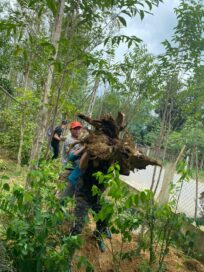- You have no items in your shopping cart
- Subtotal: $0.00
There is no 100% answer on this unless bring it to the lab which is quite costly. However, there is a technique you could use: pay attention to the “hole”. Where does it come from?
The hole was drilled, initiating the creation of agarwood forming around the wound, hence the big hole. Why not small hole? It is possible to create but it is a harder work.
With cultivated, the infected wood will be created around its wound which is the hole, to protect its from outside attack. The hole was drilled, nailed by tools so it is quite a distinctive feature and could not be covered.

Cultivated chips
Wild woodchip has multiple holes which are smaller in size, usually created by insects, ants ( PLEASE NOTE THIS IS A GENERAL GUIDE ONLY as if a seller wanted to cheat, he would do anything to cover his “products”)
Generally, agarwood chips would be stored together and had quite consistent look. You can observe multiple pieces to see different type of holes. Cultivated woodchip has an average of several centimetres wide while the wild one has smaller hole and the size of wild chip is smaller as well.

Ant chips (Wild chips)
Cultivated Agarwood Chip (big drilled holes, open-end) compared with Wild Sumatra Agarwood chip (compared the holes, smaller, caused by insects, or fungi).
The scent profile is also different, however, with this method, you need a bit of experience and a small piece to heat is needed. Testing on the spot is extremely difficult.
If the chips were collected above the hole or vertically cut, it is difficult to tell if these are cultivated wood.
Currently, in Oud Vietnam we have both cultivated Agarwood Chips and Ant Agarwood chip (natural chips). You can refer ‘Shop’ section to get more informations about product.





